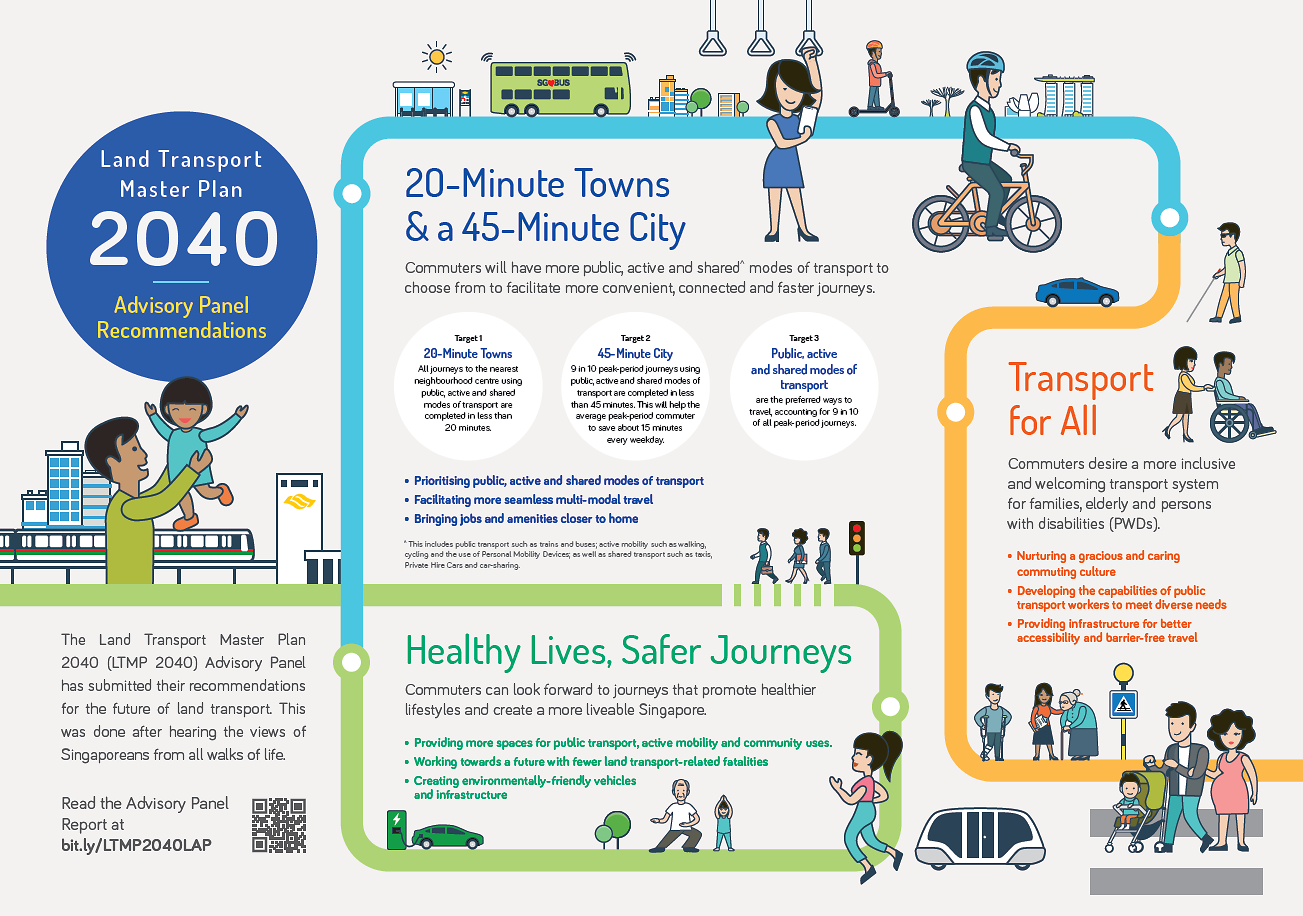SINGAPORE: An advisory panel tasked to look into Singapore’s transport master plan for 2040 submitted nine recommendations for an inclusive, well-connected and fast transport system to the Government on Friday (Feb 15).
In coming up with the recommendations, the panel led by Senior Minister of State for Transport Dr Janil Puthucheary considered more than 7,400 responses from the public in the last six months.
They fall under three key areas namely 20-minute towns and a 45-minute city, transport for all, as well as healthy lives, safer journeys. Under each key area, three recommendations have been made.

Infographic of recommendations for the Land Transport Master Plan 2040. (Source: Ministry of Transport)
20-MINUTE TOWNS AND A 45-MINUTE CITY
Under the first key area, the panel recommends that the Government work towards reducing all journeys to the nearest neighbourhood centre to under 20 minutes. Peak-period journeys should also be completed under 45 minutes.
This, the panel said, will help the average peak-period commuter save about 15 minutes every weekday.
To do this, the panel has suggested three strategies. The first is to prioritise the public transport system by growing the rail network and improving bus speeds.
First- and last-mile commutes can also be improved with better pedestrian and cycling infrastructure such as by freeing up space from roads to accommodate more Transit Priority Corridors, which has been implemented on Bencoolen Street.
Transit Priority Corridors are dedicated bus lanes and cycling paths for travel in and across towns.
Secondly, the panel suggests working towards more seamless travel by reducing the number of transfers or by better integrating multi-modal journeys by adopting technology.
The third strategy is to explore opportunities to introduce more jobs and amenities outside the city area.
TRANSPORT FOR ALL
To make public transport more inclusive, the panel recommends that the Government work towards fostering a gracious and caring commuting culture, and making more parts of the commuting journey barrier-free.
To do that, the panel recommends the training of public transport workers to identify and help those with different needs.
In addition, better infrastructure such as barrier-free access points for wheelchair and baby pram users can help these commuters enjoy travelling independently, the panel said.
The panel also suggests more platforms, such as Heart Zones, be set up to encourage Singaporeans to help other commuters in need and to recognise gracious or caring behaviour.
HEALTHY LIVES, SAFER JOURNEYS
To make Singapore’s transport system safer for use, the panel recommends that the Government dedicate more space to public transport, community uses and active mobility such as walking and cycling.
By making the walking experience more comfortable and improving how active mobility options connect to public transport, streets can be more pedestrian- and active mobility-friendly.
In spite of low accident rates, the panel urged the Government to continue giving emphasis to road safety and aiming for a “Vision Zero” environment, with fewer land transport-related fatalities. Roads and paths can be designed to enhance safety or encourage safer behaviour, for example, the panel said.
Lastly, for a better quality of life through cleaner air and a quieter environment, the panel suggests that the Government adopt cleaner and more energy-efficient fuel sources for the public bus fleet.
Shared transport operators could also consider setting targets for cleaner vehicles for taxi and private-hire car fleets.
The advisory panel was led by Senior Minister of State for Transport and Communications and Information Dr Janil Puthucheary. (Photo: Fann Sim)
“Our land transport system needs to transform, continue to support Singapore’s growth and meet the evolving needs of our commuters. It will also need to contend with technological disruptions to the industry, demographic changes and land constraints,” Dr Puthucheary said.
“The vision, targets and strategies we recommend were developed with Singaporeans’ feedback, and together, I am confident we will build a better land transport system for the future.”





